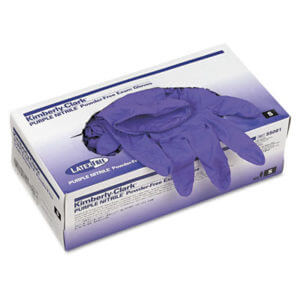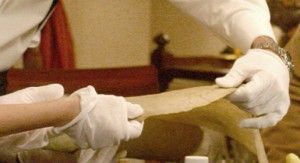They’ve been with us for years. The basket of white cotton gloves we were taught to use to handle objects, to protect objects from the oils and dirt on our hands. Many of us have moved on to using nitrile, and here’s why the rest of you need to get on the bandwagon.
- You can’t get the gloves truly clean – Don’t fool yourself. Washing them in the washing machine is not removing all the dirt from within the knit fabric of the gloves. You can see them graying. Do you want that dirt scratching photographs? Getting transferred to other objects?
- Loss of dexterity – Cotton gloves are very bulky and stretch during wear. They complicate handling jobs.
- Snagging and catching – and slippery at the same time! – White cotton gloves can be pretty abrasive. Try handling gauze with them. Try handling an ethnographic object with a compromised surface, or a surface with materials applied on it. Snag city. But at the same time, cotton gloves are slippery when handling glass or ceramics. While cotton gloves have been marketed with dots on the fingertips for grip, those dots are generally an unstable plastic that can leave corrosive deposits and cause etching of metal objects (you might as well leave your unwashed fingerprint on the object). Nitrile gloves provide a smooth surface for handling objects with complicated surfaces and just the right amount of grip.
- White cotton gloves are not a barrier between you and the object – But the object needs to be protected from me, right? Not the other way around? Wrong. Objects that may have been created with hazardous materials, treated with pesticides, or are stored where dangerous particulates (think asbestos, mouse feces carrying hanta virus, etc) may have been introduced are a risk to your health. But white cotton gloves aren’t a barrier. Nitrile gloves are.

Here’s my fav – Kimberly Clark Safeskin Powder-Free (absolute must – don’t want powder on the objects) Nitrile exam gloves.
I’m promoting nitrile because they don’t pose an allergy risk, like latex, nor do they have the potential to transfer contaminants to collections, like vinyl (and latex, as well). Yes, you need to throw away gloves. Yes, you have to order sizes to fit all of your staff members comfortably. And you need to be smart about it in order for them to protect you from possible contamination. Here’s a National Park Service Conserve-o-Gram about choosing gloves for museum work, with a really handy chart about choosing the right glove for the job.
There are certainly times where wearing any glove is dangerous for the object. Some objects require you have maximum dexterity and even nitrile can get in the way. Textile conservators doing stitching treatments can be hard pressed to do so in gloves. A good wash with soap and water prior to handling is good for the object (although wait! see below new research in 2017!) – and a second wash before eating, touching your face, or going home to your family is an absolute must for your health.
This is especially important for those of us who have started tours where visitors may come and touch artworks – see Art, Design, and Architecture Museum and Woodrow Wilson Presidential Library – we should provide them the right glove for the experience.
Update: Excellent recent conservation research by Karin Van Der Pal (Twitter @Karin_vanderPal) in support of collection stewardship indicates that washing hands accelerates the secretion of oils on fingers, making freshly washed hands more oily than they were before washing. Another vote for protecting yourself and collections with nitrile gloves, in my book, when you can (conservation treatment remains the outlier here).


Thanks for speaking up on this Becky. I have never ever felt comfortable or safe wearing cotton gloves.
We use white gloves for quilt shows. Doug found them useful for signals for our sheltie in agility. She can see what commands he is giving.
I think the US is way behind on this, most of the museums I visited in the UK three years ago had replaced white cotton gloves with synthetics.
I’ve been using nitrile since 1997. Can’t stand cotton – leaves sweat marks on metal unless you change your gloves every 5 minutes.
Interesting becky! For me cotton gloves is too thick, and you do not feel good what you have to feel. This nitrile gloves is a better option indeed, also to protect yourself when textile is VERY DIRTY!
save those white cotton gloves for tea dances.
LOL Cate.
And Connie, glad you have a use for repurposed white gloves training your Sheltie!
once I had a nasty infection of fungus because of dirt!
Yes! Museum collections can harbor hazards to human health, especially for those of us who work with them a lot. And textiles can harbor toxic dyes too. Good reason to wear nitrile gloves – especially when you aren’t sure if there is a hazard or not.
[…] Museum Monday: Get Rid of Those White Cotton Gloves. Time for Nitrile. […]